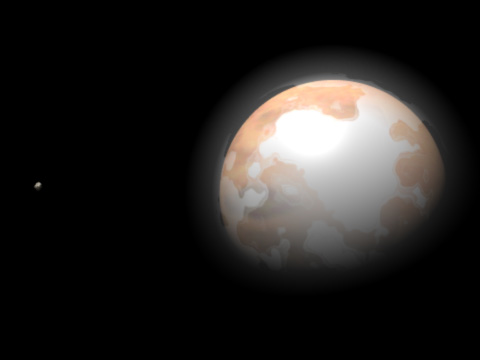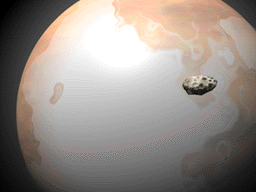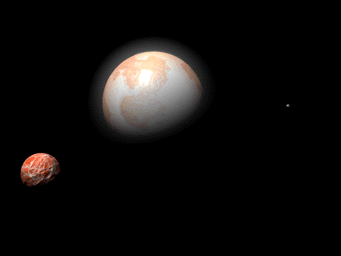
Luvah and Rahab from Livingstone I.


Last update: 17 December 1997
Luvah is perhaps the most mysterious of the Blake planets. It lies at the limit of the habitable zone at 4.5 AU, and might be either terrestrial or Jovian in nature. The nature of Luvah will depend upon what gases can be retained in its atmosphere, which is competition between temperature and gravity. The Gigantic Light flyby measured an albedo of A=0.35 for Luvah.
Questions:
The Livingstone I mission carried a high-resolution imager, magnetometer, and atmospheric drop probe to Luvah.

Luvah clearly has an extended atmosphere, as well as a surface. From a distance of 100,000 km, Luvah subtends an angular diameter of 8° 21' 6". In this close orbit, the irregular inner satellite Rahab was spotted with an orbital period of 6 hours 49 min 46 seconds and semi-major axis of 21135 km.

Questions:
The GLIP-iSOLSSAMA mission consists of an orbiter and series of small atmospheric drop probes. Both its probes and that of Livingstone I were successfully deployed, and the data is currently being analyzed.

The GLIP mission found a second moon of Luvah, named Tirzah, which orbits at a radius of 147,270 km. This moon has a reddish color similar to that of Mars, as well as peculiar surface markings. Tirzah has an equatorial radius of 1620 km. The imaging spectrometer shows an average albedo of A=0.40 for Tirzah, with spectral features indicative of water ice.
Questions:
All three missions to Luvah carried atmospheric probes. In particluar, Livingstone I and Gigantic Light carried composition analysis packages, which were able to determine that the primary constituent of Luvah's atmosphere was helium!
The GLIP mission dropped a series of atmospheric mini-probes which were
able to map out the temperature, wind, and pressure patterns over the
globe of this strange planet. Wind velocities were uncommonly high,
with speeds up to 100 km/hr typical. The surface pressure was found to
be on the order of 0.5 bar.
Questions:
smyers@nrao.edu Steven T. Myers